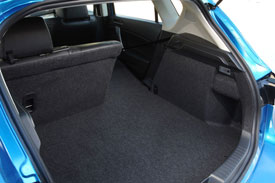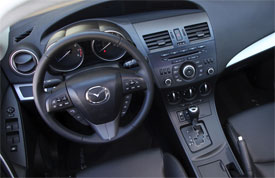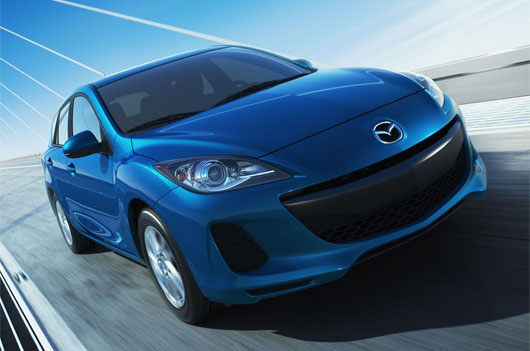2012 Mazda3 SKYACTIV
There have been a slew of new fuel saving power train technologies in recent years from hybrids to full-electrics and even fuel cells. Still, the traditional gasoline or diesel internal combustion engine is far from obsolete, and many would argue it hasn’t come close to its full potential for efficiency, especially when combined with a new whole-vehicle approach to saving fuel. And, that’s just the point of the new Mazda3 SKYACTIV.
 Mazda plans to spread its new SKYACTIV approach across the brand, but it’s the 2012 Mazda3 that is the first to bring much of the technology to market, and that’s fitting as it is Mazda’s best selling model. And one of the big reasons the Mazda3 sedan and 5-Door hatchback are so popular is because of Mazda’s zoom-zoom nature that is fully evident in the 3’s compact chassis. And while that chassis is not all-new for ’12, and therefore doesn’t get the full SKYACTIV effort, it does get an all-new power train, the heart of every fuel saving program.
Mazda plans to spread its new SKYACTIV approach across the brand, but it’s the 2012 Mazda3 that is the first to bring much of the technology to market, and that’s fitting as it is Mazda’s best selling model. And one of the big reasons the Mazda3 sedan and 5-Door hatchback are so popular is because of Mazda’s zoom-zoom nature that is fully evident in the 3’s compact chassis. And while that chassis is not all-new for ’12, and therefore doesn’t get the full SKYACTIV effort, it does get an all-new power train, the heart of every fuel saving program.
The 2-liter SKYACITV-G gasoline I4 puts out 155-horsepower, up 5-percent and 148 pound feet of torque, up 10%; all thanks to both intake and exhaust variable valve timing, direct injection, and a hefty 12-to-1 compression ratio. Low-friction transmissions are new as well, and both manual and automatic are efficient 6-speeds.
All of that makes for Government Fuel Economy Ratings of 28-City and 40-Highway for our SKYACTIV-Drive automatic. That’s a solid 20% boost over the non-SKYACTIV 2.0. The manual rates slightly lower. We average 33 miles-per-gallon of Regular in real world driving. SKYACTIV also helps the Mazda3 get a very good Energy Impact Score, burning through just 10.4-barrels of the black stuff, while emitting just 4.5 tons of CO2 per year.
As to the ‘whole car’ fuel saving aspects, the updated styling also improves aerodynamics. That includes a new front fascia with redesigned grille opening for better airflow management. Additional covers under the car help keep the air moving smoothly as the new Mazda3 sedan cuts through air with 7% less drag than before. SKYACTIV models are also set apart by a transparent blue ring in the headlights, and badging. New 16-inch alloy wheels complete the package.
 The transformation inside the cabin is a bit more thorough. A new instrument cluster adds blue accent lighting and there’s new satin trim throughout. The Multi-Information Display is now easier to read, and there’s a new shifter to go along with the new transmission, as well as new fabric choices for the seats. Touring trim adds Bluetooth and our GT a new 265-watt 10-speaker sound system. The Mazda3 is the only vehicle in this class to offer Blind Spot Monitoring. Rear seat legroom is among best-in-class, but we still felt cramped and the long, wide, flat floor trunk looks as if it would hold more than the 11.8 cubic-feet of cargo that it’s rated for.
The transformation inside the cabin is a bit more thorough. A new instrument cluster adds blue accent lighting and there’s new satin trim throughout. The Multi-Information Display is now easier to read, and there’s a new shifter to go along with the new transmission, as well as new fabric choices for the seats. Touring trim adds Bluetooth and our GT a new 265-watt 10-speaker sound system. The Mazda3 is the only vehicle in this class to offer Blind Spot Monitoring. Rear seat legroom is among best-in-class, but we still felt cramped and the long, wide, flat floor trunk looks as if it would hold more than the 11.8 cubic-feet of cargo that it’s rated for.
While the chassis is unchanged mechanically, some additional reinforcements have been added, as well as extra body welds, which helps to give the already solid feeling Mazda3 an even more unyielding feel. Through the cones, the Electro-Hyrdraulic power steering provided good feel and quick response, and the 3 gripped our cold test track well, even with snow tires. Off the line, the fuel-efficient SKYACTIV power train stood up well. The 2-liter has adequate torque right from the get-go and reached 60 in 8.9-seconds. Power quickly levels out, and the full quarter mile passes in a leisurely 16.9-seconds at 86 miles-per-hour.
As to pricing, a well equipped Mazda3i Touring SKYACTIV 4-door begins at $19,245. That’s only $350 more than a comparable non-SKYACTIV sedan. The hatchback adds $600 more to the base price.
While every manufacturer is now shooting for 40 miles-per-gallon in the compact car segment, Mazda’s whole vehicle approach, which includes not sacrificing driving enjoyment, makes the new Mazda3 a hit with us. And as Mazda expands this approach throughout their line-up, with new lighter-weight chassis’s and even diesel engines, we look forward to getting even more SKYACTIV in the future.
Specifications
- Engine: 2-liter SKYACTIV-G I4
- Horsepower: 155
- Torque: 148 lb-ft.
- 0-60 mph: 8.9 seconds
- 1/4 mile: 16.9 seconds @ 86 mph
- EPA: 28 mpg city/ 40 mpg highway
- Energy Impact: 10.4 barrels of oil/yr
- CO2 Emissions: 4.5 tons/yr
2025 Porsche Taycan Turbo GT
It’s A Turbo GT With No Turbos Or Even An Engine
In an era when even mass market EVs have mind-bending acceleration, how do performance-minded brands such as Porsche stand out? Well, you take things to an even higher level of road-going insanity. Hold on for this one! The Porsche Taycan Turbo GT just changed the game again.
When the original Porsche Taycan arrived for 2020, it did not disappoint. We blasted the Turbo S version to 60 in 2.8 seconds and hustled that hefty Hoss around Roebling Road Raceway with 911-like proficiency. None of that was enough for Porsche. So, for 2025, the Taycan gets more range, more style, more tech, and of course it does it all faster than before too. And that’s before we even get to this Porsche Taycan Turbo GT which is new to the lineup.
For our return trip to Roebling Road, there was a threat of a major winter storm about to impact our track time, so we wasted none of it, hitting the track early and often. And it’s still amazing how this big battery on wheels can feel so Porsche like. No other brand has been able to accomplish a similar feat. We laud BMW for even coming close with the i4, but here you get the full capable and confident Porsche experience; even the brakes feel incredibly natural and powerful, ceramic brakes are standard with the Turbo GT.
Having said that, it remains a very heavy vehicle, so while you’re hustling it around the track it does tend to feel more like work than fun. Many EVs dial back the power as soon as you get up to speed, but here in the Turbo GT, it never seemed to let up, building to the point we reached over 170 mph on Roebling’s front straight, and the way it powers out of corners is otherworldly.
Now, while it does absolutely shred on a racetrack, it really feels best just high-speed sweeping your way through life on some scenic roads through the countryside. This Turbo GT’s 760-kW dual-motor setup cranks out 1,019 horsepower and 914 lb-ft of torque with Launch Control, which allows for sprinting to 60 in 2.2 seconds and clearing the quarter-mile in less than 10. But alas, that winter storm arrived and covered the track in snow before we got a chance to verify that.
You get the full capable and confident Porsche experience.
All Taycans get a new rear motor for ’25, along with updated software and improvements to the cooling system. And guess what? It charges faster too, now accepting up to 320 kW, getting it to 80% in as little as 18 minutes. There’s a 30% boost to the energy capture from regen braking as well, now up to 400 kW. What the Taycan desperately needed was more range, because who wants all this fun to ever stop; and it has been increased by as much as 35% throughout the lineup, now delivering as many as 318 miles; 276 for this Turbo GT.
The Turbo GT features a unique front splitter and active rear spoiler, but all Taycans get revised styling for ’25 including upgraded lighting and a revised front clip that both improves aerodynamics and accentuates the Taycan’s substantial width. All wheels have been aerodynamically optimized as well.
Things inside look mostly the same, but they have improved the functionality of their multimedia setup, moved some controls around, and provided more standard content. It’s a borderline luxury car experience as far as amenities and tech go, yet it still has a purposeful feel to it; and whether things are covered in Race-Tex or real leather everything looks and feels great. Gauges are of course all virtual now, but they can still have a traditional look if you prefer. You really have to duck down to get into the rear seats, but space is plentiful; and with a pair of trunks, there’s abundant luggage space too.
Using 41 kilowatts of electricity for every 100 miles, the Turbo GT earns a fair Efficiency Rating. There are now more options than ever across the Taycan lineup, and that’s even before you even get to Cross Turismos and Sport Turismos. So, while this Turbo GT may cost $231,995 to start, you can get largely the same experience for as little as $101,395 for a base Taycan.
The 2025 Porsche Taycan Turbo GT is more than just a fantastic EV; it’s a great car period, and even a terrific Porsche. With the recently released Macan Electric SUV and the upcoming Boxster and Cayman EVs, more than any other brand, Porsche is giving us reasons not to fear the electrified future.
Specifications
As Tested
- Motor Setup: Dual Motor
- Battery Size: 105 kWh
- EPA Range: up to 276 miles
- Horsepower: 1,019
- Torque: 914 lb-ft
- 0-60 mph (est.): 2.2 seconds




































